Overview
- Brief Narrative
- Offset lithographic war bond advertisement poster by Harold Lehman with an image of a paratrooper about to jump from a plane. The poster was published as a contribution to the Treasury’s Schools-At-War program. Through a partnership with Associated American Artists and the United States Treasury Department, Abbott Laboratories created a program to create advertisements and illustrations for its medical journal What’s New and for the United States Government’s War Department. Reeves Lewenthal, head of the Associated American Artists, contacted Lehman and gave him free reign to design a paratrooper themed poster how he saw fit. An award winning painter, muralist and sculptor, Harold Lehman was known for making political statements with his artwork. He was born and raised in New York City, but moved to Los Angeles as a teenager, attending the Manual Arts High School. While in L.A. he befriended and worked with Phil Guston, Jackson Pollock, Reuben Kadish, and Manuel Tolegian. While in Los Angeles, he worked with David Alfaro Siqueiros as a member of the Bloc of Painters, exhibited with Lorser Feitelson and his group of Post Surrealists, and got a commission from the Public Works of Art Project (PWAP), a New Deal Federal Art Project to put artists back to work. Returning to New York City in 1935, he helped to establish the Siqueiros Experimental Workshop, and continued working on murals for the Works Project Administration (WPA) and Section of Fine Arts, Federal Work Projects. In 1941 Lehman moved to Woodstock where he pursued his own practice, as well as worked with the Treasury Department and Abbott Laboratories to create War Bond advertisements, posters, and pro-American propaganda and anti-fascist pieces to support the war effort of the Allies in World War II.
- Title
- Invest in Invasion – Buy War Bonds Poster (The Paratrooper)
- Date
-
creation:
1944
- Geography
-
distribution:
United States
- Credit Line
- United States Holocaust Memorial Museum Collection, Gift of Lisa Lehman Trager
- Markings
- front, bottom, printed, white and red ink : Invest in Invasion / BUY WAR BONDS
front, bottom margin, printed, black ink : PUBLISHED BY ABBOTT LABORATORIES AS A CONTRIBUTION TO THE TREASURY’S SCHOOLS-AT-WAR PROGRAM
back, bottom right, printed, black ink : the Artist-HAROLD LEHMAN / Harold Lehman, although today only 31 years of age, has had two / distinct art careers—one as a sculptor, the other as a painter. He / was giving great promise of rising to the front rank of American / Sculptors when he found it necessary to switch to painting since / he lacked funds necessary to acquire essential sculpture materials. / Although Lehman has been painting for only ten years, he has / already rolled up an impressive record of achievements. His first / mural exhibited at the Los Angeles Museum in 1934 was awarded / Honorable Mention. Two of his creations were purchased the follow- / ing year by the state of California and, during his six years follow- / ing, the artist was honored with the award of seven important / Federal mural commissions. He completed his last mural project / in February of 1944, and decided to devote a considerable amount / of time to easel painting. He has acquired a studio in the quiet of / Woodstock, New York, and is now at his easel many hours each day. / The artist is a member of the United American Artists and has ex- / hibited in many National exhibitions of contemporary American art. - Signature
- front, bottom, printed, black ink : H Lehman / 43? [partially obscured]
- Contributor
-
Artist:
Harold Lehman
Publisher: Abbott Laboratories
- Biography
-
Harold Lehman (1913-2006) was born in New York City, New York to Abraham and Rochel Lehman, Jewish immigrants from Europe who arrived in New York at the turn of the twentieth century. Harold was one of five children and had a twin brother. The family lived in Manhattan, and then in the Bronx. Early on, Harold’s father struggled to find consistent employment, working various jobs, including as a vaudeville dancer. He abandoned the family and moved to California, where he later found steady work as an insurance agent. Harold’s mother was a seamstress and unable to support the family by herself, so she placed Harold and his two brothers in the Hebrew Orphan Asylum. In February 1929, having aged out of the orphanage, Harold and his older brother, Charlie, moved to Los Angeles, California to reunite with their father.
Harold continued his studies in art by enrolling in Manual Arts High School. There he formed lifelong friendships with future notable artists such as Philip Guston (formerly Phillip Goldstein), Jackson Pollock, and Manuel Tolegian. Early in his art career, Harold worked primarily as a sculptor. He used plaster and clay as well as carving directly in stone. In 1930, after graduating from Manual Arts, Lehman won a citywide competition for a yearlong scholarship to the Otis Art Institute. In 1932, after leaving Otis, Harold focused on painting and began working with the Mexican muralist, David Alfaro Siqueiros. He was invited by Siqueiros to join the “Bloc of Painters,” a group of artists with socialist leanings, who were committed to using art to decry matters of social injustice of the time. The fresco murals created by this group were destroyed by the Los Angeles Red Squad. In 1933, Harold began working with Lorser Feitelson and exhibited with his group of Post Surrealist painters. He won professional recognition for his work and several awards between 1934-35 in the Los Angeles Museum’s annual competition of painters and sculptors. In 1934, together with Philip Guston and Reuben Kadish, they received a commission to do a mural under the Public Works of Art Project (PWAP), the first New Deal Federal Art Project to employ artists.
In 1935, Harold returned to New York City. He helped Siqueiros create the Siqueiros Experimental Workshop, which was dedicated to using revolutionary methods and techniques. He began experimenting with different types of paints, lacquers and application methods. The Workshop created floats and large-scale work opposing the rise and spread of fascism in Europe. In 1936 and 1937, Harold created paintings opposing the Fascists and the German and Italian intervention in the Spanish Civil War. In 1939, Harold painted a mural for the World’s Fair in New York. While working with Siqueiros, Harold also designed floats for several New York City parades promoting the Allied war effort and denouncing fascism.
In the fall of 1941, Harold fell while painting a mural and broke both his arms, which granted him a deferral from serving in World War II. He moved to Woodstock, NY to recuperate. While there, he created several war paintings for the Section of Fine Arts and the Treasury Department. Around this time, Harold was approached by Arnold Blanch and Reeves Lewenthal from the Associated American Artist Gallery. Through a partnership with Associated American Artists, the United States Treasury Department, and Abbott Laboratories a program was developed to create advertisements and illustrations for its medical journal What’s New and for the United States Government’s War Department through their School-At-War program. Using themes he was given, Harold created several posters through the auspices of the Treasury Department, which were successfully published nationwide. In 1943, two of Harold’s war posters were featured in the Museum of Modern Art’s Artists for Victory exhibit. In 1944, in response to the revelation of the atrocities of the Holocaust, before there were eyewitness accounts, Harold envisioned and drew pictures depicting the torturous conditions of prisoners in the concentration camps.
In 1946, Harold left Woodstock and returned to New York City. He continued easel painting, sculpting, and photography. He also began teaching art from his studio on West 21st Street. In 1950, Lehman met Leona Koutras, who had come to his studio for art lessons. Two years later they married and had two children. In the 1960s, Harold worked as a lead scenic artist for the 1965 New York World’s Fair and later for Expo ’67 in Montreal. In the 1970s he worked as a scenic designer and scenic artist in commercials, film, and television.
Physical Details
- Language
- English
- Classification
-
Posters
- Category
-
War propaganda
- Object Type
-
Posters, American (lcsh)
- Genre/Form
- Lithographs.
- Physical Description
- Offset lithographic poster printed on medium weight white paper encouraging people to purchase war bonds with an image of a paratrooper about to jump from a plane. He is wearing a tan flight suit, brown boots, and a green combat helmet. He leans out of the plane, his left foot forward, cradling a machine gun in his right hand and holding the doorframe with his left. The green plane has rows of rivets along the fuselage and around the door. Behind him, on the upper right, the shapes of planes and human figures parachuting down are visible in the dark sky. A red line of text extends diagonally across the lower corner of the planes opening. Across the bottom of the image there are two lines of text, one red, and one white. The image is surrounded by a white border and there is printing information at the bottom. The backside has a paragraph of black text with a shaded scrollwork border along the top and left side. There is a small piece of tape on the back.
- Dimensions
- overall: Height: 15.500 inches (39.37 cm) | Width: 11.000 inches (27.94 cm)
- Materials
- overall : paper, ink, adhesive tape
Rights & Restrictions
- Conditions on Access
- No restrictions on access
- Conditions on Use
- Restrictions on use
Keywords & Subjects
Administrative Notes
- Legal Status
- Permanent Collection
- Provenance
- The poster was donated to the United States Holocaust Memorial Museum in 2015 by Lisa Lehman Trager, the daughter of Harold Lehman.
- Record last modified:
- 2024-10-03 12:59:21
- This page:
- https://collections.ushmm.org/search/catalog/irn597139
Download & Licensing
In-Person Research
- By Appointment
- Request 21 Days in Advance of Visit
- Plan a Research Visit
- Request to See This Object
Contact Us
Also in Harold Lehman collection
The collection consists of paintings, drawings, sketches, publications, prints and photographs relating to the artist Harold Lehman and his experiences in the United States before, during, and after World War II.
Date: 1936-1945 September 02

Painting of a Civil Defense Worker turning a pipe valve by Harold Lehman
Object
Painting on board by Harold Lehman featuring a Civil Defense worker turning a valve on a large L shaped pipe. In the prelude to American involvement in World War II, the public feared attacks on populated areas, similar to those that were taking place in Europe. On May 20, 1941, President Franklin Roosevelt set up the Office of Civilian Defense (OCD) to coordinate state and federal measures to protect civilians in a war-related emergency. Trained volunteers displayed their insignia on arm bands and uniforms or civilian dress. An award winning painter, muralist and sculptor, Harold Lehman was known for making political statements with his artwork. He was born and raised in New York City, but moved to Los Angeles as a teenager, attending theManual Arts High School . While in L.A. he befriended and worked with Phil Guston, Jackson Pollock, Reuben Kadish, and Manuel Tolegian. While in Los Angeles, he worked with David Alfaro Siqueiros as a member of the Bloc of Painters, exhibited with Lorser Feitelson and his group of Post Surrealists, and got a commission from the Public Works of Art Project (PWAP), a New Deal Federal Art Project to put artists back to work. Returning to New York City in 1935, he helped to establish the Siqueiros Experimental Workshop, and continued working on murals for the Works Project Administration (WPA) and Section of Fine Arts, Federal Work Projects. In 1941 Lehman moved to Woodstock where he pursued his own practice, as well as worked with the Treasury Department and Abbott Laboratories to create War Bond advertisements, posters, and pro-American propaganda and anti-fascist pieces to support the war effort of the Allies in World War II.
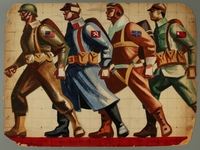
Painted gouache study of four allied soldiers standing in line for a United Front Parade float by Harold Lehman
Object
Gouache study on board by Harold Lehman depicting four uniformed soldiers, one from each of the major Allied nations of WWII. Gouache is an opaque watercolor paint. It has a heavy, velvety texture that absorbs light rather than reflecting it, which gives the paint a smooth appearance. The image was made while Lehman was working at the Siquieros Experimental Workshop in New York City and was the original sketch for a parade float for New York City’s United Front parade in 1941. The float was an advertisement for donations for the Red Cross. An award winning painter, muralist and sculptor, Harold Lehman was known for making political statements with his artwork. He was born and raised in New York City, but moved to Los Angeles as a teenager, attending theManual Arts High School . While in L.A. he befriended and worked with Phil Guston, Jackson Pollock, Reuben Kadish, and Manuel Tolegian. While in Los Angeles, he worked with David Alfaro Siqueiros as a member of the Bloc of Painters, exhibited with Lorser Feitelson and his group of Post Surrealists, and got a commission from the Public Works of Art Project (PWAP), a New Deal Federal Art Project to put artists back to work. Returning to New York City in 1935, he helped to establish the Siqueiros Experimental Workshop, and continued working on murals for the Works Project Administration (WPA) and Section of Fine Arts, Federal Work Projects. In 1941 Lehman moved to Woodstock where he pursued his own practice, as well as worked with the Treasury Department and Abbott Laboratories to create War Bond advertisements, posters, and pro-American propaganda and anti-fascist pieces to support the war effort of the Allies in World War II.
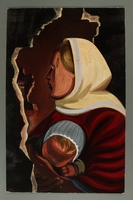
Propaganda painting of a woman and baby promoting sympathy for the Soviet Union by Harold Lehman
Object
Tempera painting on board by Harold Lehman depicting a woman holding a baby and looking through a broken wall at the ruins of a bombed out building. Tempera is a paint medium of dry pigments mixed with a water-soluble binder, such as egg yolk. This piece likely depicts the aftermath of Germany’s invasion of the Soviet Union in June 1941. An award winning painter, muralist and sculptor, Harold Lehman was known for making political statements with his artwork. He was born and raised in New York City, but moved to Los Angeles as a teenager, attending the Manual Arts High School. While in L.A. he befriended and worked with Phil Guston, Jackson Pollock, Reuben Kadish, and Manuel Tolegian. While in Los Angeles, he worked with David Alfaro Siqueiros as a member of the Bloc of Painters, exhibited with Lorser Feitelson and his group of Post Surrealists, and got a commission from the Public Works of Art Project (PWAP), a New Deal Federal Art Project to put artists back to work. Returning to New York City in 1935, he helped to establish the Siqueiros Experimental Workshop, and continued working on murals for the Works Project Administration (WPA) and Section of Fine Arts, Federal Work Projects. In 1941 Lehman moved to Woodstock where he pursued his own practice, as well as worked with the Treasury Department and Abbott Laboratories to create War Bond advertisements, posters, and pro-American propaganda and anti-fascist pieces to support the war effort of the Allies in World War II.
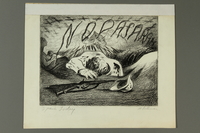
Charcoal drawing of a soldier face down on the ground with caricatured faces behind him by Harold Lehman
Object
Anti-fascist charcoal drawing by Harold Lehman depicting a Spanish Civil War soldier lying face down in hilly terrain with his rifle and helmet strewn before him. Looming behind him are three caricatured heads, likely Adolf Hitler, Francisco Franco, and Benito Mussolini. Both Hitler and Mussolini offered aid to Franco and his fascist forces during the Spanish Civil War. Floating overhead is the saying “No Pasarán” which translates to “they shall not pass.” This was a slogan used by Spanish Communist leader Dolores Ibárruri during the Siege of Madrid. With the combination of the soldier, the phrase and the faces, Lehman is saying that free people would die rather than let the fascists win. The woman and child on the left are symbols of what they are fighting for. An award winning painter, muralist and sculptor, Harold Lehman was known for making political statements with his artwork. He was born and raised in New York City, but moved to Los Angeles as a teenager, attending the Manual Arts High School. While in L.A. he befriended and worked with Phil Guston, Jackson Pollock, Reuben Kadish, and Manuel Tolegian. While in Los Angeles, he worked with David Alfaro Siqueiros as a member of the Bloc of Painters, exhibited with Lorser Feitelson and his group of Post Surrealists, and got a commission from the Public Works of Art Project (PWAP), a New Deal Federal Art Project to put artists back to work. Returning to New York City in 1935, he helped to establish the Siqueiros Experimental Workshop, and continued working on murals for the Works Project Administration (WPA) and Section of Fine Arts, Federal Work Projects. In 1941 Lehman moved to Woodstock where he pursued his own practice, as well as worked with the Treasury Department and Abbott Laboratories to create War Bond advertisements, posters, and pro-American propaganda and anti-fascist pieces to support the war effort of the Allies in World War II.
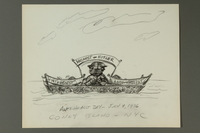
Pencil caricature of William Randolph Hearst and Adolf Hitler in a boat for Anti-Hearst Day by Harold Lehman
Object
Pencil sketch by Harold Lehman, drawn from memory in 1974, to illustrate a float that was intended to sail along the beach of Coney Island on July 4, 1936, which was proclaimed Anti-Hearst Day by the Anti-fascist movement. The sketch depicts a boat float with Adolf Hitler and William Randolph Hearst with revolving, interchangeable heads to symbolize the identical fascist positions of Hearst and Hitler. It was one of many demonstrations being organized by the American League Against War and Fascism for Anti-Hearst Day activities. William Randolph Hearst was one of the largest newspaper and magazine publishers in the United States. In the 1930s he commissioned Benito Mussolini, Adolf Hitler, and other high ranking Nazis to write columns for his papers. An award winning painter, muralist and sculptor, Harold Lehman was known for making political statements with his artwork. He was born and raised in New York City, but moved to Los Angeles as a teenager, attending the Manual Arts High School. While in L.A. he befriended and worked with Phil Guston, Jackson Pollock, Reuben Kadish, and Manuel Tolegian. While in Los Angeles, he worked with David Alfaro Siqueiros as a member of the Bloc of Painters, exhibited with Lorser Feitelson and his group of Post Surrealists, and got a commission from the Public Works of Art Project (PWAP), a New Deal Federal Art Project to put artists back to work. Returning to New York City in 1935, he helped to establish the Siqueiros Experimental Workshop, and continued working on murals for the Works Project Administration (WPA) and Section of Fine Arts, Federal Work Projects. In 1941 Lehman moved to Woodstock where he pursued his own practice, as well as worked with the Treasury Department and Abbott Laboratories to create War Bond advertisements, posters, and pro-American propaganda and anti-fascist pieces to support the war effort of the Allies in World War II.
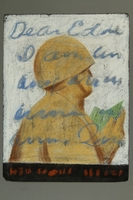
Pastel drawing of a soldier reading a letter from home by Harold Lehman
Object
Pastel drawing on paper, titled Dear Eddie, by Harold Lehman depicting a soldier reading a letter from home, the opening text of which is imposed over the image. It is one of several sketches submitted to the Treasury Department and Abbott Laboratories to create advertisements and posters supporting the war effort. An award winning painter, muralist and sculptor, Harold Lehman was known for making political statements with his artwork. He was born and raised in New York City, but moved to Los Angeles as a teenager, attending the Manual Arts High School. While in L.A. he befriended and worked with Phil Guston, Jackson Pollock, Reuben Kadish, and Manuel Tolegian. While in Los Angeles, he worked with David Alfaro Siqueiros as a member of the Bloc of Painters, exhibited with Lorser Feitelson and his group of Post Surrealists, and got a commission from the Public Works of Art Project (PWAP), a New Deal Federal Art Project to put artists back to work. Returning to New York City in 1935, he helped to establish the Siqueiros Experimental Workshop, and continued working on murals for the Works Project Administration (WPA) and Section of Fine Arts, Federal Work Projects. In 1941 Lehman moved to Woodstock where he pursued his own practice, as well as worked with the Treasury Department and Abbott Laboratories to create War Bond advertisements, posters, and pro-American propaganda and anti-fascist pieces to support the war effort of the Allies in World War II.
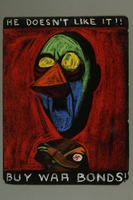
Pastel with a stylized image of Adolf Hitler encouraging Americans to buy war bonds by Harold Lehman
Object
Colorful pastel drawing on paper by Harold Lehman featuring an abstract caricature of Hitler with a disproportionately large head. The drawing is a study for a war bond advertisement poster and conveys that buying war bonds will antagonize Hitler. An award winning painter, muralist and sculptor, Harold Lehman was known for making political statements with his artwork. He was born and raised in New York City, but moved to Los Angeles as a teenager, attending the Manual Arts High School. While in L.A. he befriended and worked with Phil Guston, Jackson Pollock, Reuben Kadish, and Manuel Tolegian. While in Los Angeles, he worked with David Alfaro Siqueiros as a member of the Bloc of Painters, exhibited with Lorser Feitelson and his group of Post Surrealists, and got a commission from the Public Works of Art Project (PWAP), a New Deal Federal Art Project to put artists back to work. Returning to New York City in 1935, he helped to establish the Siqueiros Experimental Workshop, and continued working on murals for the Works Project Administration (WPA) and Section of Fine Arts, Federal Work Projects. In 1941 Lehman moved to Woodstock where he pursued his own practice, as well as worked with the Treasury Department and Abbott Laboratories to create War Bond advertisements, posters, and pro-American propaganda and anti-fascist pieces to support the war effort of the Allies in World War II.
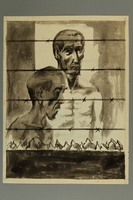
Painting of two concentration camp inmates standing behind a barbed wire fence by Harold Lehman
Object
Black-and-white, ink wash painting on paper by Harold Lehman depicting two malnourished, shirtless concentration camp inmates behind a concrete barrier with glass shards and a barbed wire fence. Harold Lehman painted this piece after learning of the Nazi atrocities in Europe, likely before there were images of the concentration camps from first hand witnesses. An award winning painter, muralist and sculptor, Harold Lehman was known for making political statements with his artwork. He was born and raised in New York City, but moved to Los Angeles as a teenager, attending the Manual Arts High School. While in L.A. he befriended and worked with Phil Guston, Jackson Pollock, Reuben Kadish, and Manuel Tolegian. While in Los Angeles, he worked with David Alfaro Siqueiros as a member of the Bloc of Painters, exhibited with Lorser Feitelson and his group of Post Surrealists, and got a commission from the Public Works of Art Project (PWAP), a New Deal Federal Art Project to put artists back to work. Returning to New York City in 1935, he helped to establish the Siqueiros Experimental Workshop, and continued working on murals for the Works Project Administration (WPA) and Section of Fine Arts, Federal Work Projects. In 1941 Lehman moved to Woodstock where he pursued his own practice, as well as worked with the Treasury Department and Abbott Laboratories to create War Bond advertisements, posters, and pro-American propaganda and anti-fascist pieces to support the war effort of the Allies in World War II.
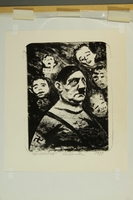
Anti-Nazi lithograph featuring Hitler surrounded by children’s faces by Harold Lehman
Object
Black-and-white, offset lithograph on paper by Harold Lehman showing Adolf Hitler ringed by several children’s ghostly faces. The image is artist Harold Lehman’s reaction to the bombing of the town of Guernica during the Spanish Civil War. In April 1937, at the request of Francisco Franco, German planes bombed Guernica, killing 1,600 civilians, destroying 70% of the town and shocking the American public. The piece was exhibited in the Alma Reed Gallery. Alma Reed was formerly an American reporter who worked in Mexico. In 1928 she left journalism and opened an art gallery in New York. An award winning painter, muralist and sculptor, Harold Lehman was known for making political statements with his artwork. He was born and raised in New York City, but moved to Los Angeles as a teenager, attending the Manual Arts High School. While in L.A. he befriended and worked with Phil Guston, Jackson Pollock, Reuben Kadish, and Manuel Tolegian. While in Los Angeles, he worked with David Alfaro Siqueiros as a member of the Bloc of Painters, exhibited with Lorser Feitelson and his group of Post Surrealists, and got a commission from the Public Works of Art Project (PWAP), a New Deal Federal Art Project to put artists back to work. Returning to New York City in 1935, he helped to establish the Siqueiros Experimental Workshop, and continued working on murals for the Works Project Administration (WPA) and Section of Fine Arts, Federal Work Projects. In 1941 Lehman moved to Woodstock where he pursued his own practice, as well as worked with the Treasury Department and Abbott Laboratories to create War Bond advertisements, posters, and pro-American propaganda and anti-fascist pieces to support the war effort of the Allies in World War II.
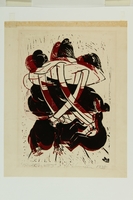
Abstract linocut print, Isolationists, depicting three figures with their heads in the clouds by Harold Lehman
Object
Black-and-red linocut print by Harold Lehman, titled Isolationists, depicting a surrealist image of three human bodies with elongated necks and their heads in a cloud. The image depicts European leaders with their heads in the clouds while war ravages the people underneath. It is a criticism of isolationists who did not want to confront Hitler to stop fascism from spreading in Europe. An award winning painter, muralist and sculptor, Harold Lehman was known for making political statements with his artwork. He was born and raised in New York City, but moved to Los Angeles as a teenager, attending the Manual Arts High School. While in L.A. he befriended and worked with Phil Guston, Jackson Pollock, Reuben Kadish, and Manuel Tolegian. While in Los Angeles, he worked with David Alfaro Siqueiros as a member of the Bloc of Painters, exhibited with Lorser Feitelson and his group of Post Surrealists, and got a commission from the Public Works of Art Project (PWAP), a New Deal Federal Art Project to put artists back to work. Returning to New York City in 1935, he helped to establish the Siqueiros Experimental Workshop, and continued working on murals for the Works Project Administration (WPA) and Section of Fine Arts, Federal Work Projects. In 1941 Lehman moved to Woodstock where he pursued his own practice, as well as worked with the Treasury Department and Abbott Laboratories to create War Bond advertisements, posters, and pro-American propaganda and anti-fascist pieces to support the war effort of the Allies in World War II.

War Bond poster sketch with drawing of a gagged man by Harold Lehman
Object
Pastel anti-Nazi sketch by Harold Lehman depicting a man with an upturned head with a black band with a red swastika around his mouth. The man is being silenced by the Nazis, showing how the authoritarian regime restricted free speech and other rights of its people. One of several sketches made to submit to the Treasury Department and Abbott Laboratories to create advertisements and posters to support the war effort. An award winning painter, muralist and sculptor, Harold Lehman was known for making political statements with his artwork. He was born and raised in New York City, but moved to Los Angeles as a teenager, attending the Manual Arts High School. While in L.A. he befriended and worked with Phil Guston, Jackson Pollock, Reuben Kadish, and Manuel Tolegian. While in Los Angeles, he worked with David Alfaro Siqueiros as a member of the Bloc of Painters, exhibited with Lorser Feitelson and his group of Post Surrealists, and got a commission from the Public Works of Art Project (PWAP), a New Deal Federal Art Project to put artists back to work. Returning to New York City in 1935, he helped to establish the Siqueiros Experimental Workshop, and continued working on murals for the Works Project Administration (WPA) and Section of Fine Arts, Federal Work Projects. In 1941 Lehman moved to Woodstock where he pursued his own practice, as well as worked with the Treasury Department and Abbott Laboratories to create War Bond advertisements, posters, and pro-American propaganda and anti-fascist pieces to support the war effort of the Allies in World War II.

Study for a poster of a soldier pulling a grenade pin with his teeth by Harold Lehman
Object
Pencil sketch by Harold Lehman of a soldier in right profile pulling the pin from a grenade with his teeth. Through a partnership with Associated American Artists and the United States Treasury Department, Abbott Laboratories created a program to produce war bond advertisement posters for distribution across the United States. Reeves Lewenthal, head of the Associated American Artists, met with Lehman and asked him to design a poster with the theme of an invasion of Europe. Lehman took a piece of Lewenthal’s note paper and immediately drew this sketch in his office, The sketch was used as a study for the poster "Get Your Might into the Fight" (see 2016.547.3). The image, a right profile close up of a soldier’s face, is an adaptation of Michelangelo’s David. In place of the sling on David’s shoulder is a grenade in the soldier’s mouth. An award winning painter, muralist and sculptor, Harold Lehman was known for making political statements with his artwork. He was born and raised in New York City, but moved to Los Angeles as a teenager, attending the Manual Arts High School. While in L.A. he befriended and worked with Phil Guston, Jackson Pollock, Reuben Kadish, and Manuel Tolegian. While in Los Angeles, he worked with David Alfaro Siqueiros as a member of the Bloc of Painters, exhibited with Lorser Feitelson and his group of Post Surrealists, and got a commission from the Public Works of Art Project (PWAP), a New Deal Federal Art Project to put artists back to work. Returning to New York City in 1935, he helped to establish the Siqueiros Experimental Workshop, and continued working on murals for the Works Project Administration (WPA) and Section of Fine Arts, Federal Work Projects. In 1941 Lehman moved to Woodstock where he pursued his own practice, as well as worked with the Treasury Department and Abbott Laboratories to create War Bond advertisements, posters, and pro-American propaganda and anti-fascist pieces to support the war effort of the Allies in World War II.
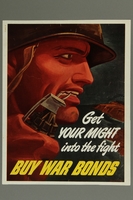
Advertisement for the US War Bond Effort featuring a soldier pulling a grenade pin with his teeth by Harold Lehman
Object
Offset lithographic advertisement for the US War Bond Effort by Harold Lehman featuring a soldier pulling a grenade pin with his teeth. Through a partnership with Abbott Laboratories and the United States Treasury Department, Associated American Artists created a program to produce war bond advertisements and posters for distribution across the United States. Reeves Lewenthal head of the Associated American Artists, met with Lehman and asked him to design a poster with the theme of an invasion of Europe. Lehman took a piece of note paper and immediately sketched the study for this poster (see 2016.547.2). The image, a right profile close up of a soldier’s face, is an adaptation of Michelangelo’s David. In place of the sling on David’s shoulder is a grenade in the soldier’s mouth. An award winning painter, muralist and sculptor, Harold Lehman was known for making political statements with his artwork. He was born and raised in New York City, but moved to Los Angeles as a teenager, attending the Manual Arts High School. While in L.A. he befriended and worked with Phil Guston, Jackson Pollock, Reuben Kadish, and Manuel Tolegian. While in Los Angeles, he worked with David Alfaro Siqueiros as a member of the Bloc of Painters, exhibited with Lorser Feitelson and his group of Post Surrealists, and got a commission from the Public Works of Art Project (PWAP), a New Deal Federal Art Project to put artists back to work. Returning to New York City in 1935, he helped to establish the Siqueiros Experimental Workshop, and continued working on murals for the Works Project Administration (WPA) and Section of Fine Arts, Federal Work Projects. In 1941 Lehman moved to Woodstock where he pursued his own practice, as well as worked with the Treasury Department and Abbott Laboratories to create War Bond advertisements, posters, and pro-American propaganda and anti-fascist pieces to support the war effort of the Allies in World War II.
Propaganda catalog featuring a series of pro-American war paintings by Thomas Hart Benton
Object
The Year of Peril: A Series of War Paintings, a catalog owned by Harold Lehman featuring reproductions of Thomas Hart Benton’s series of ten anti-fascist paintings created after the bombing of Pearl Harbor. The images show what could happen if America were to be attacked in the Midwest. Benton originally created these pieces to strengthen American patriotism and warn Americans of the dangers of isolationism. The catalog was widely distributed and part of a massive anti-fascist propaganda publicity campaign that utilized the images. Thomas Hart Benton was an artist born in Neosho, Missouri. He produced paintings, lithographs, and murals and contributed to the Regionalist Movement which captured rural American life during the 1920s. After the attack on Pearl Harbor, America was faced with an impending war. Benton, along with many other artists of the time, chose to use their work to make political statements. An award winning painter, muralist and sculptor, Harold Lehman was known for making political statements with his artwork. He was born and raised in New York City, but moved to Los Angeles as a teenager, attending the Manual Arts High School. While in L.A. he befriended and worked with Phil Guston, Jackson Pollock, Reuben Kadish, and Manuel Tolegian. While in Los Angeles, he worked with David Alfaro Siqueiros as a member of the Bloc of Painters, exhibited with Lorser Feitelson and his group of Post Surrealists, and got a commission from the Public Works of Art Project (PWAP), a New Deal Federal Art Project to put artists back to work. Returning to New York City in 1935, he helped to establish the Siqueiros Experimental Workshop, and continued working on murals for the Works Project Administration (WPA) and Section of Fine Arts, Federal Work Projects. In 1941 Lehman moved to Woodstock where he pursued his own practice, as well as worked with the Treasury Department and Abbott Laboratories to create War Bond advertisements, posters, and pro-American propaganda and anti-fascist pieces to support the war effort of the Allies in World War II.
Harold Lehman photograph collection
Document
Collection of photographs related to artist Harold Lehman’s work with the Mexican muralist David Alfaro Siqueiros to create the Siqueiros Experimental Workshop in New York City. As Siqueiros’ assistant, Harold recruited many American artists into the Workshop, including Jackson Pollock. The intention of the workshop was to use the latest available techniques targeting the public with works that were accessible and understood to support revolutions, both in society and in art. The workshop created large-scale work using industrial tools and automotive enamels and lacquers on wood panels. Participants in the Workshop were drawn to the ideas of social justice espoused by Siqueiros. An award winning painter, muralist and sculptor, Harold Lehman was known for making political statements with his artwork. He was born and raised in New York City, but moved to Los Angeles as a teenager, attending the Manual Arts High School. While in L.A. he befriended and worked with Phil Guston, Jackson Pollock, Reuben Kadish, and Manuel Tolegian. While in Los Angeles, he worked with David Alfaro Siqueiros as a member of the Bloc of Painters, exhibited with Lorser Feitelson and his group of Post Surrealists, and got a commission from the Public Works of Art Project (PWAP), a New Deal Federal Art Project to put artists back to work. Returning to New York City in 1935, he worked with Siqueiros, and continued working on murals for the Works Project Administration (WPA) and Section of Fine Arts, Federal Work Projects. In 1941 Lehman moved to Woodstock where he pursued his own practice, as well as worked with the Treasury Department and Abbott Laboratories to create War Bond advertisements, posters, and pro-American propaganda and anti-fascist pieces to support the war effort of the Allies in World War II.
Political cartoon book by David Low illustrating the history of Europe since the end of WWI
Object
Small, paperback book owned by Harold Lehman. It contains one hundred political cartoons by David Low illustrating the history of Europe from the Treaty of Versailles until the onset of World War II. David Low was a New Zealand born, self-taught artist who created political cartoons for newspapers first in New Zealand and Australia, then in Great Britain. His cartoons were later syndicated worldwide. Low satirized British politicians along with their foreign and domestic policies and developments in international politics. Low was especially critical of the fascist regimes of Adolf Hitler, Benito Mussolini, and Josef Stalin. He also criticized British Prime Minister Neville Chamberlain’s policy of appeasement toward Germany in the 1930s. Both Low and Harold Lehman were known for making political statements with their art. An award winning painter, muralist and sculptor, Harold Lehman was known for making political statements with his artwork. He was born and raised in New York City, but moved to Los Angeles as a teenager, attending the Manual Arts High School. While in L.A. he befriended and worked with Phil Guston, Jackson Pollock, Reuben Kadish, and Manuel Tolegian. While in Los Angeles, he worked with David Alfaro Siqueiros as a member of the Bloc of Painters, exhibited with Lorser Feitelson and his group of Post Surrealists, and got a commission from the Public Works of Art Project (PWAP), a New Deal Federal Art Project to put artists back to work. Returning to New York City in 1935, he helped to establish the Siqueiros Experimental Workshop, and continued working on murals for the Works Project Administration (WPA) and Section of Fine Arts, Federal Work Projects. In 1941 Lehman moved to Woodstock where he pursued his own practice, as well as worked with the Treasury Department and Abbott Laboratories to create War Bond advertisements, posters, and pro-American propaganda and anti-fascist pieces to support the war effort of the Allies in World War II.
Political cartoon book by David Low illustrating Europe during WWII
Object
Small, paperback book owned by Harold Lehman. It contains sixty political cartoons by David Low illustrating the lead up to World War II and the course of war up to 1941. All but two of the cartoons were previously published in The London Evening Standard, the Picture Post, or Collier’s newspapers. David Low was a New Zealand born, self-taught artist who created political cartoons for newspapers first in New Zealand and Australia, then in Great Britain. His cartoons were later syndicated worldwide. Low satirized British politicians along with their foreign and domestic policies and developments in international politics. Low was especially critical of the fascist regimes of Adolf Hitler, Benito Mussolini, and Josef Stalin. He also criticized British Prime Minister Neville Chamberlain’s policy of appeasement toward Germany in the 1930s. Both Low and Harold Lehman were known for making political statements with their art. An award winning painter, muralist and sculptor, Harold Lehman was known for making political statements with his artwork. He was born and raised in New York City, but moved to Los Angeles as a teenager, attending the Manual Arts High School. While in L.A. he befriended and worked with Phil Guston, Jackson Pollock, Reuben Kadish, and Manuel Tolegian. While in Los Angeles, he worked with David Alfaro Siqueiros as a member of the Bloc of Painters, exhibited with Lorser Feitelson and his group of Post Surrealists, and got a commission from the Public Works of Art Project (PWAP), a New Deal Federal Art Project to put artists back to work. Returning to New York City in 1935, he helped to establish the Siqueiros Experimental Workshop, and continued working on murals for the Works Project Administration (WPA) and Section of Fine Arts, Federal Work Projects. In 1941 Lehman moved to Woodstock where he pursued his own practice, as well as worked with the Treasury Department and Abbott Laboratories to create War Bond advertisements, posters, and pro-American propaganda and anti-fascist pieces to support the war effort of the Allies in World War II.



